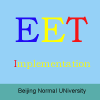-
Engaged learning for at-risk students
普通类 -
- 支持
- 批判
- 提问
- 解释
- 补充
- 删除
-
-
Engaged learning for at-risk students
LEARNERS AT-RISK OF FAILURE can gain a meaningful education using technology , but it requires a change in the basic teaching and learning process. In the past, dealing with at-risk students meant pullout programs or classes that were taught at a much lower level.-
Overview

Recent findings indicate that by not challenging at-risk students or encouraging them to use complex thinking skills, schools underestimate students’ capabilities, and deprive them of a meaningful context for learning and using the skills that are taught. (Means and Knapp 1991). Technology can help students develop positive learning relationships that will enable them to work together while creating projects and presentations.
-
Technology
In the past, schools have not focused on technology as a resource to support engaged learning. When computers are used, they are usually used for assisting students with drills and exercises instead of for cooperative and collaborative learning (DeVillar & Faltis, 1991).
Mostly technology was used individually using computers or as a whole class using videotapes. More recently, researchers in education have been calling for different uses of technology, promoting classroom activities that require students working in small groups, rather than individual learning tasks. Technology can have a powerful impact on students, helping them to organize thoughts and display information.
Using the computer, students write longer, more complex sentences and are more willing to revise and edit their work; they are able to concentrate on the thoughts they want to express rather than the mechanical skills of penmanship, spelling, and grammar. And while using technology in this manner, students are learning to use these tools just as professionals do. (Hornbeck, 1990)-
Goals
As computers become more and more a part of the educational experience, teachers will need a strong support system in the way of professional development in order to master the change in teaching strategies.
Classrooms that serve at-risk students will need to be collaborative, with students of all abilities sharing ideas and working together in teams. Activities need to be structured around student involvement in meaningful engaged learning. Students need to have the opportunities to use different types of technology to support the challenging tasks they are asked to complete.-
Teachers

Classrooms need to reflect a collaborative theme, which will help when implementing technology-based assignments. Activities will need to be developed by incorporating challenging tasks that initiate the use of technology.
Teachers need to be aware of content and how to incorporate the use of technology into their curriculum. Teachers will need to have the ability to design and implement projects using technology that require different learning levels and that will inspire students to work together.
Besides professional development, teachers need to experiment with the technology and design and implement good technology - based activities within their curricula. These activities not only take longer to implement with students but also require more advanced planning and preparation on the teacher’s part (Sheingold & Hadley, 1990).-
Author
Kathy Jones
Jones, K. (2005). Engaged Learning for At Risk Students In B. Hoffman (Ed.), Encyclopedia of Educational Technology. -
-
- 标签:
- engaged
- teachers
- activities
- at-risk
- students
- learning
- risk
- technology
-
加入的知识群:



学习元评论 (0条)
聪明如你,不妨在这 发表你的看法与心得 ~